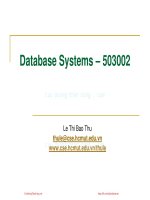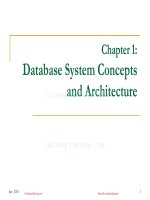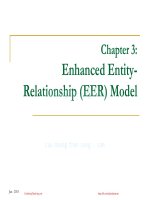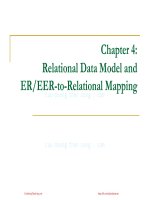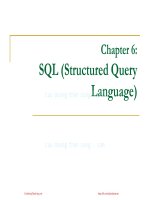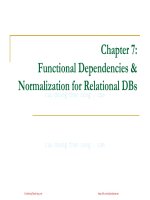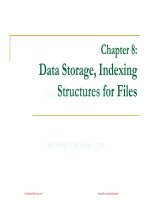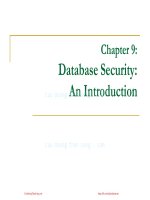cơ sở dữ liệu lê thị bảo thu chương ter c4 transaction processing sinhvienzone com
Bạn đang xem bản rút gọn của tài liệu. Xem và tải ngay bản đầy đủ của tài liệu tại đây (1.16 MB, 65 trang )
Chapter 4
Introduction to Transaction
Processing Concepts and Theory
Adapted from the slides of “Fundamentals of Database Systems” (Elmasri
et al., 2006)
CuuDuongThanCong.com
/>
1
Chapter Outline
Introduction to Transaction Processing
Transaction and System Concepts
Desirable Properties of Transactions
Characterizing Schedules based on Recoverability
Characterizing Schedules based on Serializability
Transaction Support in SQL
CuuDuongThanCong.com
/>
2
1. Introduction to Transaction Processing (1)
Single-User System: At most one user at a time can use
the system.
Multiuser System: Many users can access the system
concurrently.
Concurrency
Interleaved processing: concurrent execution of
processes is interleaved in a single CPU
Parallel processing: processes are concurrently executed
in multiple CPUs.
CuuDuongThanCong.com
/>
3
Introduction to Transaction Processing (2)
A Transaction: logical unit of database processing
that includes one or more access operations (read -retrieval,
write - insert or update, delete).
A transaction (set of operations) may be standalone specified in a high level language like SQL submitted
interactively, or may be embedded within a program.
Transaction boundaries: Begin and End transaction.
An application program may contain several
transactions separated by the Begin and End
transaction boundaries.
CuuDuongThanCong.com
/>
4
Introduction to Transaction Processing (3)
SIMPLE MODEL OF A DATABASE (for purposes
of discussing transactions):
A database - collection of named data items
Granularity of data - a field, a record , or a whole disk
block (Concepts are independent of granularity)
Basic operations are read and write
read_item(X): Reads a database item named X into a
program variable. To simplify our notation, we assume
that the program variable is also named X.
write_item(X): Writes the value of program variable X
into the database item named X.
CuuDuongThanCong.com
/>
5
Introduction to Transaction Processing (4)
READ AND WRITE OPERATIONS:
Basic unit of data transfer from the disk to the computer
main memory is one block.
Data item (what is read or written):
the field of some record in the database,
a larger unit such as a record or even a whole block.
read_item(X) command includes the following
steps:
1.
2.
3.
Find the address of the disk block that contains item X.
Copy that disk block into a buffer in main memory (if that
disk block is not already in some main memory buffer).
Copy item X from the buffer to the program variable
named X.
CuuDuongThanCong.com
/>
6
Introduction to Transaction Processing (5)
READ AND WRITE OPERATIONS (cont.):
1.
2.
3.
4.
write_item(X) command includes the following
steps:
Find the address of the disk block that contains item
X.
Copy that disk block into a buffer in main memory (if
that disk block is not already in some main memory
buffer).
Copy item X from the program variable named X
into its correct location in the buffer.
Store the updated block from the buffer back to disk
(either immediately or at some later point in time).
CuuDuongThanCong.com
/>
7
Two sample transactions. (a) Transaction T1.
(b) Transaction T2.
CuuDuongThanCong.com
/>
8
Introduction to Transaction Processing (7)
Why Concurrency Control is needed:
The Lost Update Problem.
This occurs when two transactions that access the
same database items have their operations
interleaved in a way that makes the value of some
database item incorrect.
The Temporary Update (or Dirty Read) Problem.
This occurs when one transaction updates a database
item and then the transaction fails for some reason.
The updated item is accessed by another transaction
before it is changed back to its original value.
CuuDuongThanCong.com
/>
9
Some problems that occur when concurrent execution
is uncontrolled. (a) The lost update problem.
CuuDuongThanCong.com
/>
10
Some problems that occur when concurrent execution
is uncontrolled. (b) The temporary update problem.
CuuDuongThanCong.com
/>
11
Introduction to Transaction Processing (8)
Why Concurrency Control is needed (cont.):
The Incorrect Summary Problem .
If one transaction is calculating an aggregate summary
function on a number of records while other transactions
are updating some of these records, the aggregate
function may calculate some values before they are
updated and others after they are updated.
The unrepeatable Read Problem:
Transaction T reads the same item twice and the item is
changed by another transaction T’ between the two
reads.
CuuDuongThanCong.com
/>
12
Some problems that occur when concurrent execution is
uncontrolled. (c) The incorrect summary problem.
CuuDuongThanCong.com
/>
13
Introduction to Transaction Processing (11)
Why recovery is needed:
(What causes a Transaction to fail)
1. A computer failure (system crash): A hardware or
software error occurs in the computer system during
transaction execution. If the hardware crashes, the
contents of the computer’s internal memory may be
lost.
2. A transaction or system error : Some operation in the
transaction may cause it to fail, such as integer overflow
or division by zero. Transaction failure may also occur
because of erroneous parameter values or because of
a logical programming error. In addition, the user may
interrupt the transaction during its execution.
CuuDuongThanCong.com
/>
14
Introduction to Transaction Processing (12)
Why recovery is needed (cont.):
3.
4.
Local errors or exception conditions detected by the
transaction:
- certain conditions necessitate cancellation of the
transaction. For example, data for the transaction may not
be found. A condition, such as insufficient account balance
in a banking database, may cause a transaction, such as a
fund withdrawal from that account, to be canceled.
- a programmed abort in the transaction causes it to fail.
Concurrency control enforcement: The concurrency
control method may decide to abort the transaction, to be
restarted later, because it violates serializability or because
several transactions are in a state of deadlock (see
Chapter 5).
CuuDuongThanCong.com
/>
15
Introduction to Transaction Processing (13)
Why recovery is needed (cont.):
5.
6.
Disk failure: Some disk blocks may lose their data
because of a read or write malfunction or because of
a disk read/write head crash. This may happen during
a read or a write operation of the transaction.
Physical problems and catastrophes: This refers
to an endless list of problems that includes power or
air-conditioning failure, fire, theft, sabotage,
overwriting disks or tapes by mistake, and mounting
of a wrong tape by the operator.
CuuDuongThanCong.com
/>
16
2 . Transaction and System Concepts (1)
A transaction is an atomic unit of work that is either
completed in its entirety or not done at all. For recovery
purposes, the system needs to keep track of when the
transaction starts, terminates, and commits or aborts.
Transaction states:
Active state
Partially committed state
Committed state
Failed state
Terminated State
CuuDuongThanCong.com
/>
17
State transition diagram illustrating the states for
transaction execution.
CuuDuongThanCong.com
/>
18
Transaction and System Concepts (2)
Recovery manager keeps track of the following
operations:
begin_transaction: This marks the beginning of
transaction execution.
read or write: These specify read or write operations on
the database items
end_transaction:
This specifies that read and write transaction
operations have ended and marks the end limit of
transaction execution.
may be necessary to check whether the changes
introduced by the transaction can be permanently
applied to the database or whether the transaction has
to be aborted because it violates concurrency control or
for some other reason.
CuuDuongThanCong.com
/>
19
Transaction and System Concepts (3)
Recovery manager keeps track of the following
operations (cont):
commit_transaction: This signals a successful end of
the transaction so that any changes (updates) executed
by the transaction can be safely committed to the
database and will not be undone.
rollback (or abort): This signals that the transaction
has ended unsuccessfully, so that any changes or
effects that the transaction may have applied to the
database must be undone.
CuuDuongThanCong.com
/>
20
Transaction and System Concepts (4)
Recovery techniques use the following operators:
undo: Similar to rollback except that it applies to a
single operation rather than to a whole transaction.
redo: This specifies that certain transaction
operations must be redone to ensure that all the
operations of a committed transaction have been
applied successfully to the database.
CuuDuongThanCong.com
/>
21
Transaction and System Concepts (6)
The System Log
Log or Journal :
The log keeps track of all transaction operations that
affect the values of database items.
This information may be needed to permit recovery
from transaction failures.
The log is kept on disk not affected by any type of
failure except for disk or catastrophic failure.
In addition, the log is periodically backed up to
archival storage (tape) to guard against such
catastrophic failures.
CuuDuongThanCong.com
/>
22
Transaction and System Concepts (7)
The System Log (cont):
Types of log record:
1.
[start_transaction,T]: Records that transaction T has started
execution.
2.
[write_item,T,X,old_value,new_value]: Records that
transaction T has changed the value of database item X from
old_value to new_value.
3.
[read_item,T,X]: Records that transaction T has read the
value of database item X.
4.
[commit,T]: Records that transaction T has completed
successfully, and affirms that its effect can be committed
(recorded permanently) to the database.
5.
[abort,T]: Records that transaction T has been aborted.
CuuDuongThanCong.com
/>
23
Transaction and System Concepts (8)
The System Log (cont):
Protocols for recovery that avoid cascading
rollbacks do not require that READ operations be
written to the system log, whereas other protocols
require these entries for recovery.
Strict protocols require simpler WRITE entries that
do not include new_value.
CuuDuongThanCong.com
/>
24
Transaction and System Concepts (9)
Recovery using log records:
If the system crashes, we can recover to a consistent database
state by examining the log and using one of the techniques
described in Chapter 6.
Because the log contains a record of every write operation that
changes the value of some database item, it is possible to undo
the effect of these write operations of a transaction T by tracing
backward through the log and resetting all items changed by a
write operation of T to their old_values.
We can also redo the effect of the write operations of a
transaction T by tracing forward through the log and setting all
items changed by a write operation of T (that did not get done
permanently) to their new_values.
CuuDuongThanCong.com
/>
25
